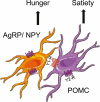Mechanisms of Weight Loss After Obesity Surgery
- PMID: 34363458
- PMCID: PMC8755990
- DOI: 10.1210/endrev/bnab022
Mechanisms of Weight Loss After Obesity Surgery
Abstract
Obesity surgery remains the most effective treatment for obesity and its complications. Weight loss was initially attributed to decreased energy absorption from the gut but has since been linked to reduced appetitive behavior and potentially increased energy expenditure. Implicated mechanisms associating rearrangement of the gastrointestinal tract with these metabolic outcomes include central appetite control, release of gut peptides, change in microbiota, and bile acids. However, the exact combination and timing of signals remain largely unknown. In this review, we survey recent research investigating these mechanisms, and seek to provide insights on unanswered questions over how weight loss is achieved following bariatric surgery which may eventually lead to safer, nonsurgical weight-loss interventions or combinations of medications with surgery.
Keywords: Obesity surgery; eating behavior; energy expenditure; gut hormones; weight loss.
© The Author(s) 2021. Published by Oxford University Press on behalf of the Endocrine Society. All rights reserved. For permissions, please e-mail: journals.permissions@oup.com.
Figures




References
-
- Mason EE, Ito C. Gastric bypass in obesity. Surg Clin North Am. 1967;47(6):1345-1351. - PubMed
-
- Wittgrove AC, Clark GW, Tremblay LJ. Laparoscopic gastric bypass, Roux-en-Y: preliminary report of five cases. Obes Surg. 1994;4(4):353-357. - PubMed
-
- Olbers T, Lönroth H, Fagevik-Olsén M, Lundell L. Laparoscopic gastric bypass: development of technique, respiratory function, and long-term outcome. Obes Surg. 2003;13(3):364-370. - PubMed
-
- Brethauer SA, Hammel JP, Schauer PR. Systematic review of sleeve gastrectomy as staging and primary bariatric procedure. Surg Obes Relat Dis. 2009;5(4):469-475. - PubMed
-
- Burton PR, Brown WA. The mechanism of weight loss with laparoscopic adjustable gastric banding: induction of satiety not restriction. Int J Obes (Lond). 2011;35(Suppl 3):S26-S30. - PubMed
Publication types
MeSH terms
Grants and funding
LinkOut - more resources
Full Text Sources
Medical

